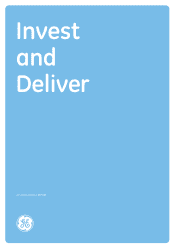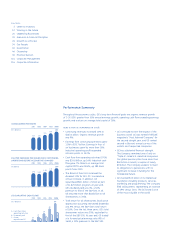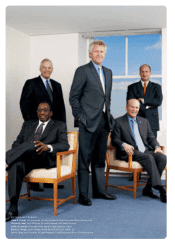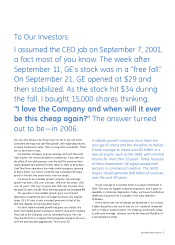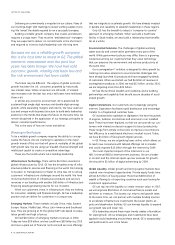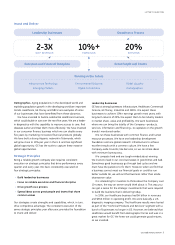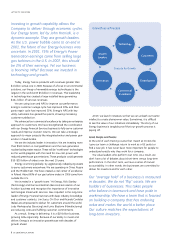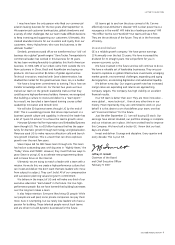GE 2006 Annual Report Download - page 9
Download and view the complete annual report
Please find page 9 of the 2006 GE annual report below. You can navigate through the pages in the report by either clicking on the pages listed below, or by using the keyword search tool below to find specific information within the annual report.
Execution and Financial Discipline
Building a reliable growth company requires excellent execution
around margin expansion, cash flow generation and the capital
allocation required to achieve high returns. These results must
be achieved with high levels of transparency and controllership.
We must deliver to earn the “right” to invest.
The core of our financial strength is the ability to generate
excess cash. In 2007, we should generate $40 billion of cash from
earnings, working capital reductions and potential divestitures.
This is cash that will be available after we have invested in R&D,
programming and capital expenditures.
We allocate this cash with discipline. Our first priority is to pay
your dividends. We are committed to return 50% of our earnings
back to you in dividends. We reinvest 60% of our fi nancial ser-
vices earnings to sustain their future growth. That still leaves
$20 billion to drive industrial growth through acquisitions and
to buy back stock.
As I mentioned earlier, we like investing in the Company
and have announced almost $15 billion of industrial acquisitions
for 2007. We target every investment to achieve a 20% return
over time. We should also complete our current $25 billion stock
buyback program by 2008.
Our return hit 18.4% in 2006, a 180 basis point improvement.
We are on track to hit 20% by 2008. With a return of 20% and
capital cost of 9%, our investments create signifi cant economic
value. Any private equity firm would “die” for our unlevered returns.
Another way we improve investor returns is
through a detailed focus on margin expansion.
GE’s operating profit rate hit 15.2% in 2006, a
40 basis point improvement from the previous
year. We have targeted a 100 basis point
improvement for 2007. We should achieve gains
through improving the mix of our high-margin
services, driving product line profi tability and
lowering overhead costs.
GE’s long-term commitment to services growth will benefi t
our investors. Our services revenues were $30 billion in 2006
and are growing more than 10% annually. With margin rates
of nearly 30%, services have a significantly positive impact on
GE’s profitability, and should fuel our margin rate growth for
many years.
We drive a lean structure through our simplifi cation initiative.
Our overhead costs have declined by $4 billion since 2004.
We are consolidating backrooms, restructuring old facilities and
reducing management layers. Corporate costs should decline
5% in 2007. This initiative still has years of opportunity ahead.
We continue to use tools such as Lean, a process for reduc-
ing cycle time, and Six Sigma to reduce working capital. Our
Transportation business has reduced the cycle time needed to
build a locomotive from 31 days to 26 days, with a target of 10
days. This has created 30% more capacity and reduced inventory
by 30%. This business has an ROTC of 33%.
Our financial services businesses are also very profi table.
The returns in Commercial Finance and GE Money exceed 25%.
We have great origination and excellent risk management, and
our capital markets capability allows us to keep only the highest
margin assets on our books.
Risk management is an important skill at GE. We manage
more than $560 billion of financial assets with losses less than the
industry average. The GE Capital Board meets monthly, where we
approve all our significant deals. Before each meeting, our Chief
Risk Officer, Jim Colica, sends a memo to the Board refl ecting his
views of each deal. I spend an hour alone with Jim to review each
deal through his eyes. There is no “deal heat” in my conference
room. Jim’s keen eye for detail has saved GE billions.
We are committed to having transparent and high-quality
earnings. By that, we mean earnings that convert into cash and
are repeatable. Over the past five years, 100% of our earnings
have been converted into cash. Meanwhile, we believe the com-
bined impact of non-cash pension effects, gains, restructuring
and changes in tax rate — financial elements that are a part of a
company our size — basically offset each other over time. GE’s
earnings are driven by our businesses, which should always be
transparent and well understood by investors.
A key part of our operating discipline is excellence in control-
lership. While I am confident in our processes and culture, we did
restate our earnings from 2001 to 2005 due to differing accounting
interpretations between us, together with our auditors, and the
U.S. Securities and Exchange Commission. The restatement did
not have a significant impact on our financial position, but the
outcome is unacceptable. We are strengthening our processes
even further.
Building a reliable growth company requires the generation
of cash and the discipline to invest with high returns. It requires
ongoing process excellence to improve margins and returns over
time. Invest and deliver; this is our responsibility and a “right”
that we earn by executing over time.
Growth as a Process
We have invested in capabilities that create organic growth.
These capabilities include investing in leadership technology and
innovation, taking an enterprise approach to customers and
positioning GE for global success. Over the past two years, our
organic growth has averaged 8%, higher than our industrial and
financial peers, and twice our historic average.
Our focus on technology has created a pipeline of 40 “$1 billion-
revenue products” that will be introduced in the next three years.
This results in an installed base that should generate decades of
services growth. Improving customer value has made the Company
more externally focused. We are further enhancing customer value
throughout the Company using Lean and Net Promoter Score
(NPS), a tool to measure how customers view GE. We are increas-
ing share through commercial excellence. Enterprise selling is
creating accelerated growth in Commercial Finance, Healthcare,
Infrastructure and NBCU. Our increased focus on globalization
has transformed GE. Our global revenues should equal our
U.S. revenues in 2007 and grow at 15% annually. Innovation
has become mainstream. We should have 60 Imagination
Breakthroughs generating $25 billion revenues in 2007, and
we have another 90 in the pipeline.
ge 2006 annual report 7

